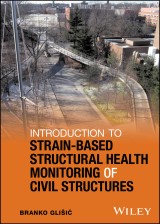Details
Introduction to Strain-Based Structural Health Monitoring of Civil Structures
1. Aufl.
|
76,99 € |
|
| Verlag: | Wiley |
| Format: | |
| Veröffentl.: | 26.06.2024 |
| ISBN/EAN: | 9781118700303 |
| Sprache: | englisch |
| Anzahl Seiten: | 368 |
DRM-geschütztes eBook, Sie benötigen z.B. Adobe Digital Editions und eine Adobe ID zum Lesen.
Beschreibungen
<p> <i><b>A comprehensive introduction to strain-based structural health monitoring of civil structures, with focus on measurement and data analysis </b></i> <p><i>Introduction to Strain-Based Structural Health Monitoring of Civil Structures </i>focuses on the SHM of civil structures and infrastructure, and develops the relevant topics of measurement and data analysis from a fundamental to advanced level. <p>The book contains an overview of the available and emerging strain monitoring technologies like traditional strain-gauges and vibrating wire sensors, discrete and distributed fiber optic sensors, and large area electronics. The fundamentals of error analysis, as well as typical sources of errors in measurements, are discussed. Sources of strain in typical construction materials such concrete, steel, timber, and composite materials are also discussed, while both basic and advanced data interpretation and analysis for monitoring of concrete and steel structures are presented in detail. <p>Methods applicable to a large spectrum of beam-like structural elements and civil structures, such as bridges, buildings, and pipelines, are summarized. These methods are developed at three scales: local scale (material or structural), global (structural) scale, and integrity scale, and are illustrated with practical examples. <p>Key features: <ul><li>Defines and describes SHM and identifies its main components and stakeholders. </li><li>Explores the potential and benefits as well as the limitations of SHM. </li><li>Introduces strain-based structural health monitoring of civil structures, with focus on measurement and data analysis. </li><li>Covers the physical principles, advantages, and limitations of various types of sensors. </li><li>Covers fundamental error analysis and presents typical sources of errors. </li><li>Covers the sources of short- and long-term strain, and how to interpret the strain measurement. </li><li>Includes basic and advanced model-based methods for data analysis. </li><li>Contains the basic strain-based SHM methods for monitoring various types of structures at local, global, and integrity scale. </li><li>Suitable as a guide for practicing engineers, a reference for infrastructure owners, and a textbook for researchers and SHM university courses. </li><li>A valuable companion to Glisic & Inaudi’s <i>Fibre Optic Methods for Structural Health Monitoring</i>. </li></ul> <p><i>Introduction to Strain-Based Structural Health Monitoring of Civil Structures </i>is essential, state-of-the-art reading for civil and structural engineers and professionals in SHM, as well as teachers, researchers, and students in civil engineering.
<p><b>Branko Glisic</b> is an Assistant Professor of Civil and Environmental Engineering at Princeton University, USA. His main areas of interest are SHM methods, advanced sensory systems, smart structures, SHM data management, and sustainable engineering.</p> <p>He was previously employed at SMARTEC SA, Switzerland, where he was involved in research and engineering in numerous structural health monitoring projects.</p>
<p><b>Introduction to Strain-Based Structural Health Monitoring of Civil Structures</b></p> <p>Branko Glisic, Princeton University, USA</p> <p> </p> <p><b><i>A comprehensive introduction to strain-based structural health monitoring of civil structures, with focus on measurement and data analysis</i></b></p> <p><i>Introduction to Strain-Based Structural Health Monitoring of Civil Structures</i> focuses on the SHM of Civil Structures and Infrastructure, and develops the relevant topics of measurement and data analysis from a fundamental to advanced level.</p> <p>The book contains an overview of the available and emerging monitoring technologies, for example, traditional strain-gauges, fiber optic sensors, and large area electronics. The fundamental criteria for applications of SHM technologies on concrete, steel and composite materials are also discussed, and both basic and advanced data interpretation and analysis for static and dynamic monitoring are presented in detail.</p> <p>Methods applicable to a large spectrum of civil structures such as bridges, buildings, and geo-structures are summarized. These methods are illustrated with practical examples.</p> <p> </p> <p>Key features:</p> <p>• Introduces strain-based structural health monitoring of civil structures, with focus on measurement and data analysis.</p> <p>• Contains the basic strain-based SHM methods for monitoring various types of structures.</p> <p>• Covers the physical principles, advantages and limitations of various types of sensors.</p> <p>• Covers the sources of static and dynamic strain, and how to interpret the strain measurement.</p> <p>• Includes basic and advanced methods for static and dynamic data analysis.</p> <p>• Explores the potential and benefits as well as the limitations of SHM.</p> <p>• Suitable as a guide for practicing engineers, reference for infrastructure owners, and textbook for researchers and SHM university courses.</p> <p> </p> <p><i>Introduction to Strain-Based Structural Health Monitoring of Civil Structures</i> is essential, state-of-the-art reading for civil and structural engineers and professionals in SHM, as well as teachers, researchers and students in civil engineering.</p>
Diese Produkte könnten Sie auch interessieren:

Introduction to Strain-Based Structural Health Monitoring of Civil Structures

von: Branko Glisic

76,99 €

Entwicklung eines FEM-Beinmodells zur Simulation der Interaktion mit einer Prothese

von: Guangxu Chen

36,99 €















